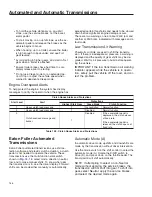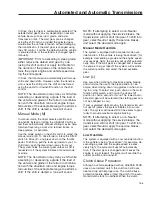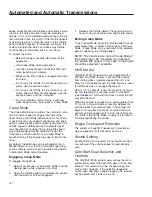
Brake System Warnings, Indicators, and Messages
Telltale
Color
Description
Driver Display
N/A
ATC Deactivated
Indicates the ATC SPIN button has been
pressed to allow wheel slip.
03/01/2016
f611336
Green
Engine Brake
Indicates the engine brake is enabled.
N/A
Table 13.1, Brake System Warnings, Indicators, and Messages
IMPORTANT: In the event of a total loss of ser-
vice brakes with full system air pressure, use
the parking brake control valve (yellow knob) to
bring the vehicle to a complete stop in the saf-
est location possible.
Before a vehicle with insufficient system air pressure
can be moved, the spring parking brakes must be
released by applying an external air source at the
gladhands, or by manually caging the parking brake
springs.
WARNING
Do not release the spring parking brakes and
then drive the vehicle. There would be no means
of stopping the vehicle, which could result in se-
rious personal injury or vehicle damage. Before
releasing the spring parking brakes, make the
connection to a towing vehicle or chock the tires.
After correcting the brake system problem, uncage
the spring parking brakes before resuming normal
vehicle operation.
Loss of air pressure in the primary air system causes
the rear service brakes to become inoperative. The
secondary air system will continue to operate the
front brakes and the trailer brakes (if equipped).
Loss of air pressure in the secondary air system
causes the front axle brakes to become inoperative.
The primary air system will continue to operate the
rear service brakes and the trailer brakes (if
equipped).
Brake System Operation
Before driving your vehicle, allow time for the air
compressor to build up a minimum of 100 psi (689
kPa) pressure in both the primary and secondary
systems. Monitor the air pressure system by observ-
ing the air pressure gauges and the low-air-pressure
warning light and buzzer. The warning light and
buzzer shut off when air pressure in both systems
reaches approximately 70 psi (483 kPa).
IMPORTANT: Before driving the vehicle, secure all
loose items in the cab so that they will not fly forward
during a full brake application. Make sure all passen-
gers are wearing seat belts.
During normal brake stops, depress the foot brake
control pedal until braking action slows down the ve-
hicle. Increase or decrease the pressure on the
pedal so that the vehicle comes to a smooth, safe
stop. Apply the spring parking brakes if the vehicle is
to be parked.
IMPORTANT: An air brake proportioning system
may be used in tractor air brake systems when
the vehicle is not equipped with antilock braking
system (ABS). When operating in bobtail mode,
the rear brake chambers (on which the axle
load has been greatly reduced) receive reduced
(proportional) air pressure, while the front axle
brake chambers receive full (normal) air pres-
sure. This results in a different brake pedal
"feel," as the pedal seems to require more travel
and/or effort to slow or stop the vehicle. How-
ever, the air brake proportioning system actually
improves vehicle control when the tractor is in
Brake Systems
13.2
Summary of Contents for NEW CASCADIA 2016
Page 1: ... NEW CASCADIA Driver s Manual Part Number STI 500 Publication Number STI 500 8 ...
Page 5: ......
Page 11: ......
Page 38: ...f611444 10 31 2016 Fig 3 23 Sample Alert Messages Instruments 3 20 ...
Page 39: ......
Page 93: ......
Page 94: ...8 Cab and Sleeper Features Windows 8 1 Mirrors 8 1 Cab Amenities 8 1 Sleeper Amenities 8 2 ...
Page 99: ......
Page 125: ......
Page 134: ...14 Steering System Power Steering System 14 1 ...
Page 145: ......
Page 146: ...16 Manual Transmissions and Clutch Eaton Fuller Manual Transmissions 16 1 Clutch 16 1 ...
Page 149: ......
Page 150: ...17 Drive Axles Interaxle Lock Tandem Axles 17 1 Driver Controlled Differential Lock DCDL 17 2 ...
Page 164: ...19 Trailer Couplings Holland Trailer Coupling 19 1 ...
Page 177: ......
Page 191: ......
Page 198: ...25 Specifications Fluids and Lubricants 25 1 ...






























